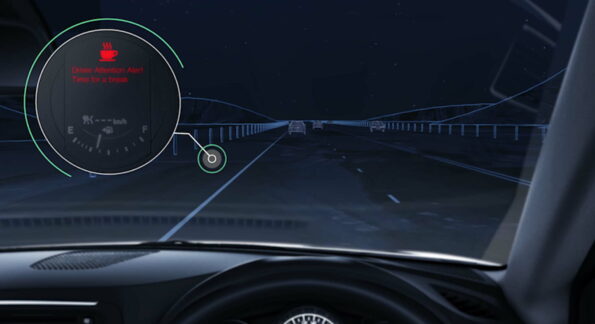Some vehicles warn a driver if they are showing signs of sleepiness or fatigue. These systems are generally called driver drowsiness detection systems and they work in 3 main ways:
Timer
A simple timer, usually set at around 2 hours, reminds the driver that they should pull over and have a break. This doesn’t work in reducing sleepiness long term unless the driver has a nap – the only thing that can ultimately stop sleepiness is sleep, although it can be delayed a bit with caffeine and a few other methods. The timer might only be activated under certain driving conditions, for example, greater than 80km/h for 2 hours.
Monitoring steering and vehicle position
When a driver gets tired they start to lose concentration behind the wheel and drift in the lane. For example, the rumble strip or cat’s eyes wake the driver up, leading to a rapid correction in trajectory. The vehicle can detect these. This system doesn’t work if the vehicle is using an automatic lane departure warning or lane keeping function such as Lane Keep Assist.
The vehicle might also use forward facing cameras to verify the driver is drifting out of the lane.

Monitoring blinking and head position
Some systems have a camera that looks at the driver’s face and eyes. When a driver gets tired, their frequency of blinking goes down (i.e. they don’t blink as many times per minute), but the length of the blink increases from around 0.1 seconds to 0.2 seconds. This equates to an extra 2.8m travelled with your eyes closed at 100km/h.
Also, when a driver is sleepy, their eyes start to droop and their head starts to drop forwards, only to be snatched backwards as the driver is jolted back to alertness again.
These systems provide vibration and/or audio alerts to let the driver know they are falling asleep. They still rely on the driver to make the right decision and pull over to have a nap.
Future technology
Some companies are looking at technology which monitors the driver’s heart rate, body posture and breathing patterns to give a more effective warning. These systems could be used in autonomous cars in the future to take over when the driver is getting sleepy and find a safe place to stop. They might also be able to change the interior temperature of the vehicle to help stave off sleepiness for a few minutes longer.
These systems have to learn a driver’s characteristics before they are effective.
